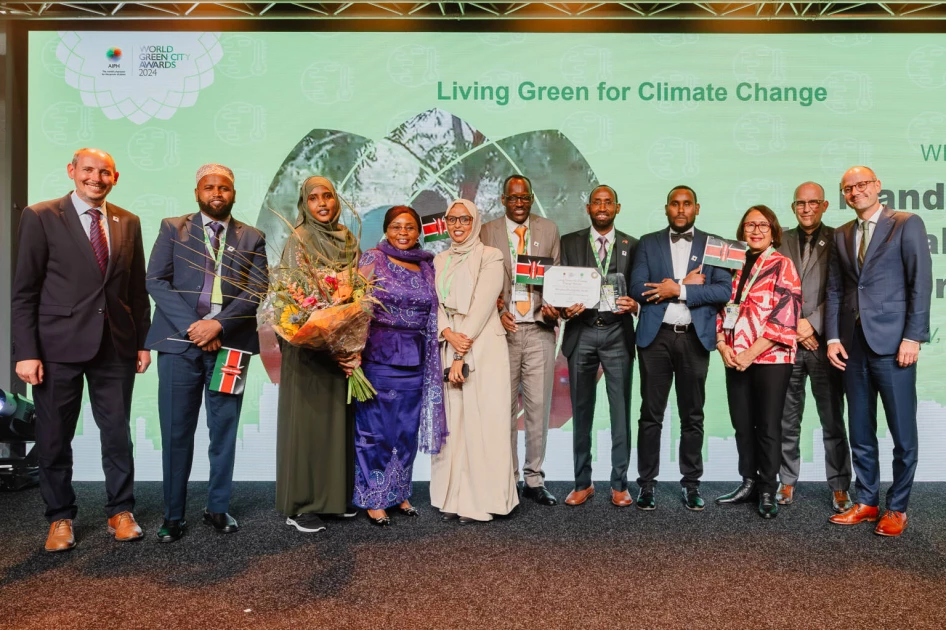OPINION: This is how Kenya can plant 15 billion trees by 2032

The Mandera team at the World Green City Awards in Utrecht, September 2024. Photo I Courtesy
Kenya has a very ambitious goal: to restore 10.6 million hectares of degraded land by planting 15 billion trees by the year 2032.
This looks ambitious on paper, but I believe it can be done. Eight years is enough time for Kenyans to make it a reality, and this is why.
Eight years ago, Mandera Municipality was famously known as the place of dust. This is after extensive lands were destroyed by asylum seekers from neighbouring Somalia who sought refuge in Mandera.
This was further exacerbated by Mandera’s climatic conditions characterised by arid and semi-arid climates, frequent droughts, limited vegetation cover, widespread desertification, and soil and wind erosion.
However, through a tree-planting program focused on environmental conservation and restoration, Mandera Municipality has been able to combat wind and soil erosion, reduce the impact of climate change, and regenerate the natural water cycle. Today, we are known as the “Green County.”
Harsh realities in Mandera
Mandera’s environment is unforgiving, with extreme temperatures, minimal precipitation and recurrent droughts. The need for change was urgent.
This led to the birth of Mandera Municipality Greening and Afforestation and Mandera Green Future program – a holistic intervention to Mandera’s unique environmental and socio-economic circumstances.
First, we wanted to mitigate the effects of the harsh climate by fostering tree growth, providing shade and creating a cooler environment.
Secondly, there are high poverty and unemployment rates in Mandera. This program has helped us hit two birds with one stone - not only address climate challenges but also provide stable income opportunities for the vulnerable.
The main economic activity in Mandera County is pastoralism, contributing approximately 72 per cent of the total household income.
Cross-border trade, artisanal mining, beekeeping and irrigation-aided agriculture are the other viable ventures. All these activities are affected by climate.
Each year, the county and national governments spend millions of shillings on drought mitigation programs focusing on water supply and pasture management. We know this is not going to be sustainable in the long term.
Getting everyone involved
In Mandera, we say, we do not plant trees, we grow them. We systematically plant and nurture trees and have an established water infrastructure to support sustainable forest growth.
The program actively engages 1,300 participants, a substantial portion of whom are women and youth. These individuals receive monthly stipends, enhancing family stability.
Local schools and communities are also integral participants, fostering a culture of environmental stewardship while addressing unemployment and improving food, nutrition, health and economic security.
The county has set up nurseries for seedlings with a capacity of 250,000 seedlings. Tree species, planting sites and water are all supported by the County Mandera through the Green Future program.
The seedlings are carefully planted at the selected sites according to recommended spacing and planting techniques.
Seedlings are gently placed in the holes, and the soil is backfilled and compacted around the roots to provide stability and support.
After planting, the newly planted seedlings are watered to help them establish root systems and overcome transplant shock.
Mulch is also applied around the base of the newly planted seedlings to conserve soil moisture, suppress weed growth, and moderate soil temperature.
Addressing water scarcity
One major obstacle is the reliance on River Daua, which is prone to seasonal drying, impacting consistent water access for tree planting and maintenance.
To tackle this issue the program explored alternative water sources like boreholes and rainwater harvesting systems to reduce dependency on the river.
Additionally, the project focuses on planting drought-resistant species and implementing water conservation techniques such as drip irrigation and mulching to optimize water usage.
We have also installed underground and elevated water storage tanks, regularly replenished by water bowsers. This infrastructure ensures the consistent hydration of our trees, crucial in a region with minimal rainfall.
From dusty to Green County
Eight years later, we have seen the impact. The transformation has not only improved the quality of life of Mandera residents but also contributed to climate resilience.
Trees have transformed Mandera Municipality’s landscape from a dusty town to a lush, green hub. Trees provide shade, cool breezes, and a more pleasant environment for residents, enhancing their quality of life.
Vulnerable individuals now have a steady source of income and indigenous communities have embraced the program, replicating it in their communities and schools.
This sense of ownership ensures the initiative’s long-term sustainability.
The active engagement of Indigenous communities, schools and youth was crucial to fostering environmental awareness and sustainable practices.
Schools and youth actively participate in tree nurturing, fostering a culture of environmental responsibility from an early age. Their involvement was necessary for the program’s success.
Mandera Municipality’s Afforestation and Greening Programme and Mandera Green Future is an example of how Kenya can practically address climate change through tree planting.
We now have an ambitious goal set of achieving climate neutrality objectives or net zero by 2030.
These goals will require even higher emission cuts or carbon sequestration which in turn means we must halt desertification and restore our nature until we reach the point where the release of greenhouse gases into the atmosphere is balanced with the capture and storage of these gases in our trees and soil.
Global recognition
In October, Mandera Municipality’s Afforestation and Greening Program and Mandera Green Future were among the 21 finalists in the AIPH World Green City Awards.
This is the first and only global award for cities where plants and nature are the core focus. As an ongoing competition with entries open every two years, the Awards recognise the role of cities, municipalities and urban authorities in promoting and supporting greater inclusion of plants and nature in urban environments.
The program won the Living Green For Climate Change Award beating Liverpool City and Melbourne City.
The Award looked at the benefits of greening, addressing urban challenges, positive solutions, the ability to measure and report impact, measuring resilience and learning and transferability.
This has now put Kenya on the global map as a country that is serious about combating climate change.
Mandera has shown that it is possible to restore our cities, towns and urban centres into greener, more comfortable spaces for people to live in.
It is possible to turn adversity into opportunity and offer a brighter future for our residents.
The author is the CECM Lands, Housing and Urban Development County Government of Mandera, and Chair Mandera Green Future and Land Sector Forum Chair - FCDC.
Email: diwanisalah01@gmail.com
Want to send us a story? SMS to 25170 or WhatsApp 0743570000 or Submit on Citizen Digital or email wananchi@royalmedia.co.ke
Comments
No comments yet.


Leave a Comment